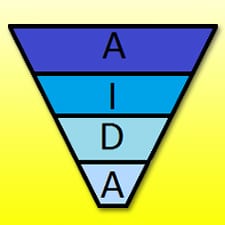Here's a useful post from Josh Peters on Mashable. Referencing the old and still highly relevant "AIDA" funnel - it may appeal as a starting point to those of you more familiar with that framework.

It works because each section of AIDA represents a section of your sales and marketing process and can help you set your KPI's, decide what to monitor, and visualize the relationships between each part. Also - as Josh notes "understanding the flow of the tools and tactics will also help you get your measurements and analytics in line with your goals".
Of course the boundaries of AIDA can get muddy - people can easily go through multiple levels at once. It"€™s not perfect, but then what is? AIDA is one option to help shape your social marketing strategy and help focus and prioritise your goals.
- Awareness: This is the basics - and where the staple Facebook, Twitter, LinkedIn and You Tube networks come in. As Chris Brogan notes, these are the "outposts" that lead back to your hub. You can see this in Dave's Radar visualisation earlier this month relating to this. The goal here is reach, people knowing you are there - measure the sentiment and volume conversations and mentions around your brand primarily.
- Interest: This is about getting the product or service into the mind of the customer. I'd probably disagree a little with Josh on this one since I think interest is garnered more from aligning product or service benefits to the unmet needs (real or emotional) in the mind of the visitor. The goal here for me would be click through to the main site/hub and into the main pages of your site - pages that answer "is this for people like me". Clearly content from past customers is useful here, a powerful integration point for social media, customers talking freely about their experience with your brand.
- Desire: Now were onto real engagement on your site - clicks on to more detailed product pages and the nitty-gritty of features, price and options. Site design is more pertinent at this stage and integration to tight ratings, reviews and short testimonials is highly relevant. Think about video based content as well. Goals could be time on product pages and bounce rate, Josh also mentions inbound links as a metric which is great.
- Action: These are the end metrics in the sense of an outcome or transaction. So we're specifically thinking about purchase, sign-up, call-me-back, lead forms etc. We're not really about social media at this stage - it's about your site.
A note on Social CRM
Of course, the process doesn't end there, AIDA helps for planning and optimising that linear journey. We know that success and growth comes from inspiring repeat purchase and referral. It's critical that the very channels a customer used to find and come into your business are used to support post purchase. This requires your listening and interacting with customers in social networks and that "marketing" are not the only team interacting on those networks. The goal of Social CRM? Advocacy. The point where a customer just wants to share your story across their networks for you.
By definition of doing Social CRM well you are helping spread more Awareness, foster repeat or new Interest and fuelling Desire with great new content and inbound links.







